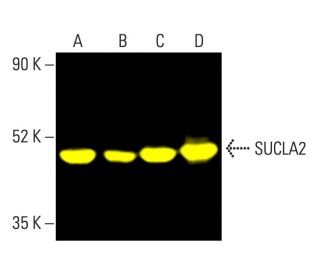
SUCLA2 Antibody (A-9): sc-374107
- SUCLA2 Antibody (A-9) is a mouse monoclonal IgG1 κ SUCLA2 antibody provided at 200 µg/ml
- specific for an epitope mapping between amino acids 59-93 near the N-terminus of SUCLA2 of human origin
- SUCLA2 Antibody (A-9) is recommended for detection of SUCLA2 of mouse, rat and human origin by WB, IP, IF, IHC(P) and ELISA; also reactive with additional species, including bovine
- Anti-SUCLA2 Antibody (A-9) is available conjugated to agarose for IP; HRP for WB, IHC(P) and ELISA; and to either phycoerythrin or FITC for IF, IHC(P) and FCM
- also available conjugated to Alexa Fluor® 488, Alexa Fluor® 546, Alexa Fluor® 594 or Alexa Fluor® 647 for WB (RGB), IF, IHC(P) and FCM, and for use with RGB fluorescent imaging systems, such as iBright™ FL1000, FluorChem™, Typhoon, Azure and other comparable systems
- also available conjugated to Alexa Fluor® 680 or Alexa Fluor® 790 for WB (NIR), IF and FCM; for use with Near-Infrared (NIR) detection systems, such as LI-COR®Odyssey®, iBright™ FL1000, FluorChem™, Typhoon, Azure and other comparable systems
- m-IgG Fc BP-HRP, m-IgG1 BP-HRP and m-IgGκ BP-HRP are the preferred secondary detection reagents for SUCLA2 Antibody (A-9) for WB and IHC(P) applications. These reagents are now offered in bundles with SUCLA2 Antibody (A-9) (see ordering information below).
QUICK LINKS
SEE ALSO...
SUCLA2 Antibody (A-9) is a mouse monoclonal IgG1 kappa light chain antibody that detects SUCLA2 protein of mouse, rat, and human origin by western blotting (WB), immunoprecipitation (IP), immunofluorescence (IF), immunohistochemistry, and enzyme-linked immunosorbent assay (ELISA). SUCLA2 Antibody (A-9) is available in non-conjugated and various conjugated forms, including agarose, horseradish peroxidase (HRP), phycoerythrin (PE), fluorescein isothiocyanate (FITC), and multiple Alexa Fluor® conjugates. SUCLA2, also known as succinate-CoA ligase, ADP-forming, beta subunit, A-BETA, SCS-betaA, or renal carcinoma antigen NY-REN-39, is a crucial 463 amino acid enzyme located in the mitochondrial matrix that plays a vital role in the tricarboxylic acid cycle by dimerizing with the SCS alpha subunit to form the succinyl-CoA synthetase complex. This complex is essential for energy production, catalyzing the conversion of succinyl-CoA to succinate, generating ATP or GTP in the process. Defects in SUCLA2 are implicated in autosomal recessive disorders known as Mitochondrial DNA depletion syndromes (MDSs), characterized by reduced mitochondrial DNA copy numbers in affected tissues, leading to severe clinical manifestations such as progressive external ophthalmoplegia, ataxia-neuropathy, and mitochondrial neurogastrointestinal encephalomyopathy. Two isoforms of SUCLA2 arise from alternative splicing, highlighting the complexity and regulatory mechanisms of this important protein.
Alexa Fluor® is a trademark of Molecular Probes Inc., OR., USA
LI-COR® and Odyssey® are registered trademarks of LI-COR Biosciences
SUCLA2 Antibody (A-9) References:
- Interaction between succinyl CoA synthetase and the heme-biosynthetic enzyme ALAS-E is disrupted in sideroblastic anemia. | Furuyama, K. and Sassa, S. 2000. J Clin Invest. 105: 757-64. PMID: 10727444
- Deficiency of the ADP-forming succinyl-CoA synthase activity is associated with encephalomyopathy and mitochondrial DNA depletion. | Elpeleg, O., et al. 2005. Am J Hum Genet. 76: 1081-6. PMID: 15877282
- Mitochondrial encephalomyopathy with elevated methylmalonic acid is caused by SUCLA2 mutations. | Ostergaard, E., et al. 2007. Brain. 130: 853-61. PMID: 17287286
- SUCLA2 mutations are associated with mild methylmalonic aciduria, Leigh-like encephalomyopathy, dystonia and deafness. | Carrozzo, R., et al. 2007. Brain. 130: 862-74. PMID: 17301081
- Mutation of RRM2B, encoding p53-controlled ribonucleotide reductase (p53R2), causes severe mitochondrial DNA depletion. | Bourdon, A., et al. 2007. Nat Genet. 39: 776-80. PMID: 17486094
- Inherited mitochondrial diseases of DNA replication. | Copeland, WC. 2008. Annu Rev Med. 59: 131-46. PMID: 17892433
- Disorders caused by deficiency of succinate-CoA ligase. | Ostergaard, E. 2008. J Inherit Metab Dis. 31: 226-9. PMID: 18392745
- Mitochondrial DNA depletion syndrome due to mutations in the RRM2B gene. | Bornstein, B., et al. 2008. Neuromuscul Disord. 18: 453-9. PMID: 18504129
- Clinical and molecular features of mitochondrial DNA depletion syndromes. | Spinazzola, A., et al. 2009. J Inherit Metab Dis. 32: 143-58. PMID: 19125351
Ordering Information
| Product Name | Catalog # | UNIT | Price | Qty | FAVORITES | |
SUCLA2 Antibody (A-9) | sc-374107 | 200 µg/ml | $316.00 | |||
SUCLA2 Antibody (A-9): m-IgG Fc BP-HRP Bundle | sc-529662 | 200 µg Ab; 10 µg BP | $354.00 | |||
SUCLA2 Antibody (A-9): m-IgGκ BP-HRP Bundle | sc-522624 | 200 µg Ab, 40 µg BP | $354.00 | |||
SUCLA2 Antibody (A-9): m-IgG1 BP-HRP Bundle | sc-543627 | 200 µg Ab; 20 µg BP | $354.00 | |||
SUCLA2 Antibody (A-9) AC | sc-374107 AC | 500 µg/ml, 25% agarose | $416.00 | |||
SUCLA2 Antibody (A-9) HRP | sc-374107 HRP | 200 µg/ml | $316.00 | |||
SUCLA2 Antibody (A-9) FITC | sc-374107 FITC | 200 µg/ml | $330.00 | |||
SUCLA2 Antibody (A-9) PE | sc-374107 PE | 200 µg/ml | $343.00 | |||
SUCLA2 Antibody (A-9) Alexa Fluor® 488 | sc-374107 AF488 | 200 µg/ml | $357.00 | |||
SUCLA2 Antibody (A-9) Alexa Fluor® 546 | sc-374107 AF546 | 200 µg/ml | $357.00 | |||
SUCLA2 Antibody (A-9) Alexa Fluor® 594 | sc-374107 AF594 | 200 µg/ml | $357.00 | |||
SUCLA2 Antibody (A-9) Alexa Fluor® 647 | sc-374107 AF647 | 200 µg/ml | $357.00 | |||
SUCLA2 Antibody (A-9) Alexa Fluor® 680 | sc-374107 AF680 | 200 µg/ml | $357.00 | |||
SUCLA2 Antibody (A-9) Alexa Fluor® 790 | sc-374107 AF790 | 200 µg/ml | $357.00 | |||
SUCLA2 (A-9) Neutralizing Peptide | sc-374107 P | 100 µg/0.5 ml | $68.00 |
